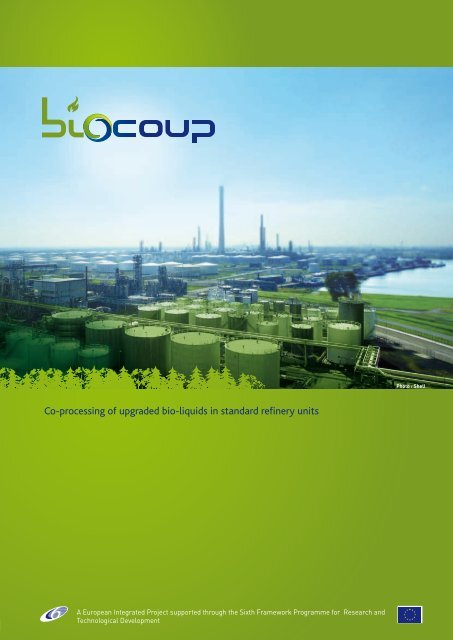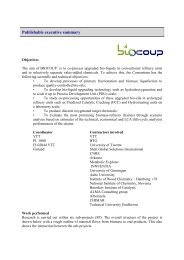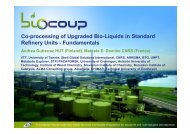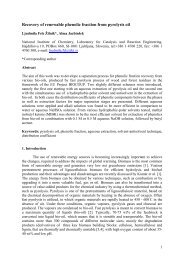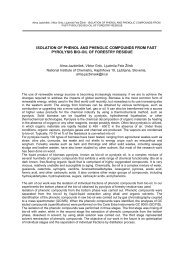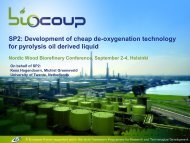Co-processing of upgraded bio-liquids in standard ... - Biocoup
Co-processing of upgraded bio-liquids in standard ... - Biocoup
Co-processing of upgraded bio-liquids in standard ... - Biocoup
You also want an ePaper? Increase the reach of your titles
YUMPU automatically turns print PDFs into web optimized ePapers that Google loves.
<strong>Co</strong>-<strong>process<strong>in</strong>g</strong> <strong>of</strong> <strong>upgraded</strong> <strong>bio</strong>-<strong>liquids</strong> <strong>in</strong> <strong>standard</strong> ref<strong>in</strong>ery units<br />
A European Integrated Project supported through the Sixth Framework Programme for Research and<br />
Technological Development<br />
Photo : Shell
Energy plays a crucial role <strong>in</strong> modern life. Its consumption grew by around 2% a year <strong>in</strong> the decade 1990-2000, and it is expected to<br />
grow even more <strong>in</strong> 2000-2020.<br />
Whilst fossil fuels rema<strong>in</strong> by far the ma<strong>in</strong> source <strong>of</strong> energy, the development <strong>of</strong><br />
renewable energies is an <strong>in</strong>vestment for a clean and susta<strong>in</strong>able energy future.<br />
Indeed, the use <strong>of</strong> renewable energy sources <strong>in</strong> place <strong>of</strong> fossil fuels reduces emission<br />
pollutants, <strong>in</strong>clud<strong>in</strong>g greenhouse gases and it improves the security <strong>of</strong> supply by<br />
promot<strong>in</strong>g the diversification <strong>of</strong> energy production. They are clearly favoured by the<br />
Europeans.<br />
In the EU renewable energy sources provided about 6% <strong>of</strong> the total energy<br />
requirements and the objective is for that share to reach 12% <strong>in</strong> 2010. This target<br />
was first set <strong>in</strong> 1997 by the European <strong>Co</strong>mmission <strong>in</strong> its White Paper “Energy for<br />
the future renewable sources <strong>of</strong> energy”. Reach<strong>in</strong>g this target would lead to a CO2<br />
reduction <strong>of</strong> 320 million tonnes per year (compared to about 130 million tonnes<br />
currently). The important role <strong>of</strong> renewable energies <strong>in</strong> susta<strong>in</strong>able development<br />
and climate change was acknowledged <strong>in</strong> the United National World Summit on<br />
Susta<strong>in</strong>able Development that was held <strong>in</strong> Johannesburg <strong>in</strong> 2002. The development<br />
<strong>of</strong> renewable energies will also contribute towards a weaker reliance on energy<br />
imports and the fulfill<strong>in</strong>g <strong>of</strong> <strong>in</strong>ternational obligations such as the Kyoto protocol.<br />
The ma<strong>in</strong> sources <strong>of</strong> renewable energy <strong>in</strong>clude w<strong>in</strong>d, photovoltaics, solar thermal heat<strong>in</strong>g and cool<strong>in</strong>g, geothermal heat, and <strong>bio</strong>mass.<br />
Biomass represents today nearly two-thirds <strong>of</strong> all the renewable energy sources, and it is it only renewable source that can be used<br />
to produce competitively-priced liquid fuels for transport. It will therefore play a significant role <strong>in</strong> the grow<strong>in</strong>g production and use <strong>of</strong><br />
renewable energies.<br />
One key challenge is to optimise reliable, efficient and cost effective technologies for the<br />
conversion <strong>of</strong> <strong>bio</strong>mass.<br />
The BIOCOUP Integrated Project coord<strong>in</strong>ated by VTT <strong>in</strong> F<strong>in</strong>land is aimed at develop<strong>in</strong>g a<br />
cha<strong>in</strong> <strong>of</strong> process steps to allow a range <strong>of</strong> different <strong>bio</strong>mass feedstocks to be co-fed to a<br />
conventional oil ref<strong>in</strong>ery to produce energy and oxygenated chemicals.<br />
The overall objective is to respond to the <strong>in</strong>creas<strong>in</strong>g demand <strong>of</strong> bi<strong>of</strong>uels with a new<br />
<strong>in</strong>novative <strong>process<strong>in</strong>g</strong> route.<br />
The overall <strong>in</strong>novation derives from <strong>in</strong>tegration <strong>of</strong> <strong>bio</strong>-feedstock procurement with exist<strong>in</strong>g non-food <strong>in</strong>dustries (energy, pulp and paper)<br />
and <strong>process<strong>in</strong>g</strong> <strong>of</strong> the <strong>upgraded</strong> <strong>bio</strong>mass <strong>in</strong> exist<strong>in</strong>g m<strong>in</strong>eral oil ref<strong>in</strong>eries. This will allow a seamless <strong>in</strong>tegration <strong>of</strong> <strong>bio</strong>-ref<strong>in</strong>ery co<strong>process<strong>in</strong>g</strong><br />
products to the end-consumers for products such as transport fuels and chemicals, and thus provide an important stimulus<br />
to <strong>bio</strong>mass acceptance and further technological development <strong>of</strong> <strong>bio</strong>mass production routes.
The project is organised as 6 Sub-Projects with the follow<strong>in</strong>g objectives :<br />
SP1 Fractionation and liquefaction <strong>of</strong> the <strong>bio</strong>mass<br />
In order to reduce the costs <strong>of</strong> primary <strong>bio</strong>-oils, an <strong>in</strong>novative<br />
<strong>in</strong>tegrated <strong>bio</strong>-oil concept will be developed from a number <strong>of</strong><br />
viable <strong>bio</strong>mass feedstocks. These oils will be used <strong>in</strong> subsequent<br />
de-oxygenation processes.<br />
SP2 De-oxygenation <strong>of</strong> <strong>bio</strong>-oils<br />
Primary <strong>bio</strong>-<strong>liquids</strong> typically have oxygen contents <strong>of</strong> about 50%<br />
and cannot be processed <strong>in</strong> <strong>standard</strong> ref<strong>in</strong>ery units. Current deoxygenation<br />
processes are not mature and are expensive due to<br />
high hydrogen consumption and costs. The BIOCOUP consortium<br />
aims to develop new <strong>in</strong>tegrated approaches to decrease this<br />
oxygen content.<br />
SP3 Evaluation <strong>of</strong> <strong>upgraded</strong> <strong>bio</strong>-oils <strong>in</strong> <strong>standard</strong> ref<strong>in</strong>ery units<br />
The opportunities for <strong>bio</strong>mass co-<strong>process<strong>in</strong>g</strong> <strong>in</strong> <strong>standard</strong> ref<strong>in</strong>ery<br />
units will be assessed, regard<strong>in</strong>g the technical and economical<br />
feasibility. The parameters <strong>of</strong> the ref<strong>in</strong>ery units most viable for<br />
<strong>bio</strong>-liquid co-<strong>process<strong>in</strong>g</strong> will be def<strong>in</strong>ed, as well as their change<br />
depend<strong>in</strong>g on the <strong>bio</strong>-liquid specifications.<br />
SP4 Production <strong>of</strong> chemicals from <strong>bio</strong>mass<br />
One <strong>of</strong> the characteristics <strong>of</strong> the produced <strong>bio</strong>-<strong>liquids</strong> over crude<br />
oil is their high content <strong>of</strong> oxygenates.<br />
This sub-project will therefore also aim at develop<strong>in</strong>g technologies<br />
for the conversion <strong>of</strong> these <strong>bio</strong>-<strong>in</strong>termediates to valuable<br />
products by chemical processes, for develop<strong>in</strong>g processes for the<br />
transformation <strong>of</strong> <strong>in</strong>termediates and the production <strong>of</strong> <strong>in</strong>dustrial<br />
oxygenated chemicals. It will also <strong>in</strong>clude the synthesis <strong>of</strong> <strong>bio</strong>liquid<br />
derived thermosett<strong>in</strong>g adhesives .<br />
Biomass<br />
residues<br />
Primary<br />
liquefaction<br />
De-oxygenation<br />
UT<br />
Scenario analysis<br />
<strong>Co</strong>ord<strong>in</strong>ation<br />
SP5 Scenario and life cycle analysis<br />
The most promis<strong>in</strong>g optimised <strong>bio</strong>mass-ref<strong>in</strong>ery cha<strong>in</strong>s (<strong>bio</strong>mass<br />
feedstocks → f<strong>in</strong>al products) will be assessed both technically and<br />
economically.<br />
SP6 Transversal activities<br />
Dissem<strong>in</strong>ation <strong>of</strong> the knowledge generated with BIOCOUP will<br />
be an important activity organised <strong>in</strong> this sub-project. It will also<br />
support the management <strong>of</strong> the project so that the objectives are<br />
achieved with allocated resources.<br />
Solid phased Extraction Fractionation :<br />
SPE Manifold SPE Eluates<br />
SPE Chromatograms<br />
<strong>Co</strong>-<strong>process<strong>in</strong>g</strong><br />
<strong>in</strong> petroleum<br />
ref<strong>in</strong>ery<br />
Shell Global Solutions<br />
International<br />
<strong>Co</strong>nversion<br />
TU/e<br />
GC-MS/FID<br />
<strong>Co</strong>nventional<br />
fuels<br />
and<br />
chemicals<br />
Oxygenated<br />
products
Photo : Shell<br />
An <strong>in</strong>ternational consortium has been established to explore this <strong>in</strong>novative route call<strong>in</strong>g for cogeneration <strong>of</strong><br />
bi<strong>of</strong>uels and chemicals.<br />
Supported by the European commission through the Sixth Framework<br />
Programme for Research and Development with a grant up to 7.6 M€,<br />
the BIOCOUP project addresses the T6 thematic priority : “Susta<strong>in</strong>able<br />
development, global change and ecosystems”. The project is runn<strong>in</strong>g s<strong>in</strong>ce<br />
May 2006 and will last 60 months.<br />
www.<strong>bio</strong>coup.eu<br />
BTG<br />
UT<br />
Shell Global Solutions<br />
RUG<br />
ALBEMARLE<br />
TUE<br />
CNRS-IRC<br />
ARKEMA<br />
METEX<br />
ALMA<br />
INNVENTIA<br />
VTT<br />
Aalto<br />
BIC<br />
NIC<br />
vTi<br />
CHIMAR<br />
Project <strong>Co</strong>ord<strong>in</strong>ator:<br />
VTT, Yrjö Solantausta, + 358 20 72 25 517 - yrjo.solantausta@vtt.fi<br />
EC Project Officer:<br />
European <strong>Co</strong>mmission, Dr Maria GEORGIADOU, +32-2-29 59 846 - maria.georgiadou@ec.europa.eu<br />
With the support <strong>of</strong>:<br />
ALMA <strong>Co</strong>nsult<strong>in</strong>g Group, Christ<strong>in</strong>e Robertson, +33 4 72 35 80 30 - crobertson@almacg.com<br />
Création :: <strong>Co</strong>mète :: www.comete.com


